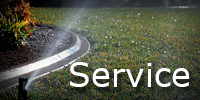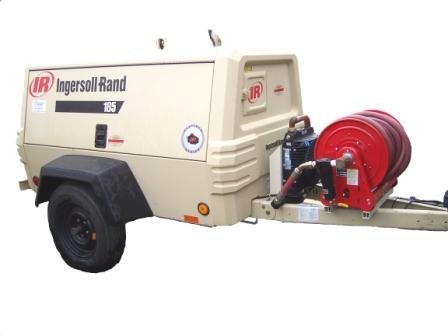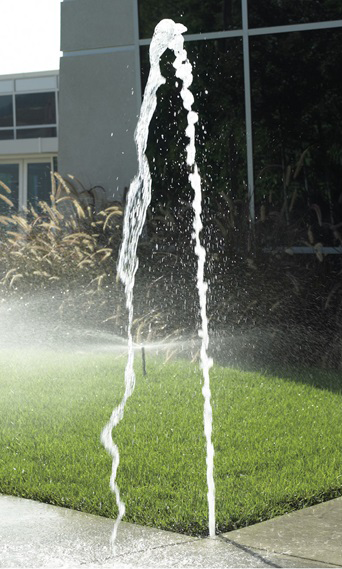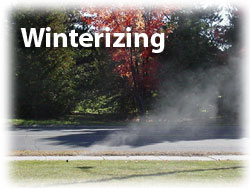Service - Everything from Spring Openings, Winterizing, Broken Heads, Renovations, Leaking Valves, clogged Nozzles and more to keep your irrigation system running in top form Spring Openings:
Fall Is Here....Time To Winterize We start our winterizings the 1st of October and continue into November. You never know when the frost will come so don't wait until the last minute. Book Early! |
|||||
SERVICE
AND MAINTENANCE
We understand how important it is to have proper irrigation, especially during the warmer months. That's why we provide a quick response time, and immediate emergency service should the need arise. You'll never wait days or weeks for one of our highly-trained service technicians to care for your service needs. We do repairs and upgrades on our systems and systems that we didn't install. In addition, we provide critical maintenance services at specific intervals to keep your irrigation system running at optimal output. These interval maintenance services include System Winterization, Spring Turn-On, and an In-Season Check-Up. As Our customer, you will receive the exceptional service you deserve.
|
|||||
Sprinkler Maintenance Water conservation is of the utmost importance to all of us. LawnSprinklers.ca can help customers conserve water by precise timing that eliminates any overwatering. |
|||||
If your sprinkler is not doing what it's supposed to do or what you want it to do, our Irrigation technicians will evaluate the situation and solve your problem quickly and professionally. |
|||||
|
|||||
| Without proper preparation your sprinkler system can be damaged by freezing temperatures. Here are some tips from Rain Bird on how to prepare your irrigation system if you live in a region where it freezes. | |||||
1. Insulate your assets. Shut off the water supply to the irrigation system. The main shut off valve for your irrigation system needs to be protected against freezing. To prevent it from freezing make sure it is wrapped with insulation (foam insulation tape and a plastic bag), or somehow protected from freezing. If you do not have a main shut off valve, consider it a preventative investment. Any above ground piping needs to be insulated. Self-sticking foam-insulating tape or foam insulating tubes commonly found at home supply stores, are fine. |
|||||
2. Stay in control. If you have an automatic system then you will need to "shut down" the controller (timer). Most controllers have a “rain-mode" which simply shuts off the signals to the valves. The controller continues to keep time, the programming information (start times, valve run times, etc,) isn't lost, and the clock continues to run. The only change is that the valves will not activate. If your controller is responsible for activating a pump, as a precaution, remove the wires that are connected to the MV and common. This will prevent the possibility of the pump from being activated which could cause overheat damage. An alternative to using the rain mode is simply to shut off the power to the controller. If you do, you'll need to reprogram the time and potentially all your other settings as well, in the spring. |
|||||
3. Drain the pipes. Now you need to remove the water from the pipes and sprinklers so that it won't freeze and break the pipe. There are several ways to drain your pipes: the manual drain valve, the automatic drain valve or the compressed air blow-out methods. However, since there could be potential safety risks we recommend contacting your local irrigation specialist. |
|||||
4. Protect valves and backflow preventers. Insulate backflow preventers and valves if they are above ground. You can also use insulation tape for this. Do not block the air vents and drain outlets on backflow preventers. Please review the Rain Bird Homeowner's Guide to Winterization for detailed instructions on how to prepare your irrigation system for the Winter months. Rain Bird Homeowner's Guide to Winterization |
|||||
| Troubleshooting Quick Guide | |||||
WATER DOES NOT TURN OFF When a part of the system stays on well after it was scheduled to shut down, you know there is a problem. Sometimes the problem is an improperly set irrigation controller. In other instances, there is a mechanical failure with a control valve and the system will need to be turned off at the main water source. |
|||||
TURNING OFF YOUR CONTROLLER Every type of controller, mechanical or digital, will have some type of OFF position. Some makes of controllers label the OFF position as RAIN OFF or simply RAIN. If turning off the controller fails to shut the system down, you must go next to the main water source for the irrigation system. |
|||||
TURNING OFF THE SYSTEM AT THE WATER SOURCE Every sprinkler system, if properly installed according to local codes, should have a separate cut off for the irrigation system. There may be a lever type handle or gate valve type handles (something like large faucet handles). Don't be surprised if you find the handles either broken or partially broken, they are notorious for twisting off due to corrosion. If the handles are gone, you may still be able turn off the water with a pair of channel locks or vice grips. Once the crises is solved, you should call a professional repair technician to locate and repair the problem. |
|||||
CONSTANT WET AREA If you have a wet spot in your lawn, first turn on your sprinkler system to see if you can spot any obvious problems. Next, be sure your controller has not malfunctioned and that you are not over watering. Turn your sprinkler system off at the control panel for a couple of days to see in this corrects the problem. If the problem persists, turn off the water at the main water supply. If the leak is in your lawn sprinkler system, the area should dry within a couple of days. |
|||||
CONTROLLER When your electronic or digital controller does not operate properly and/or will not accept a program you should try to clear the display. Remove the back up battery and unplug the controller from the wall. After approximately 15 seconds, re-power the controller and see if this solved your problem. Sometimes these controllers are affected by a power surge that causes the memory to scramble and you simply need to clear the memory. If this fails to solve your problem, you may need to call an irrigation technician. |
|||||
How To Adjust Rotor Sprinkler Heads Technical Information on Valves |
|||||

 So much more than just turning the water and timer on.
So much more than just turning the water and timer on.

